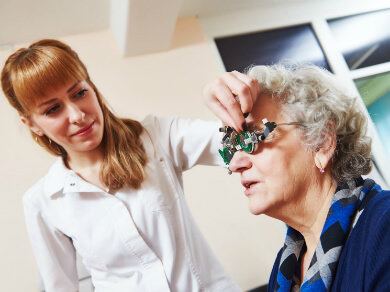Time for another look: calls to change the eye test for drivers

Breakdown provider GEM asked its members whether they thought that ongoing testing of drivers’ eyesight would make the roads safer, and 87 per cent said it would.
Currently, rules say L-test candidates only have to pass a basic eye test when they take their driving test. This consists of reading a number plate from 20 metres (65ft), with glasses or contact lenses if needed.
However, the law does lay down a minimum eyesight standard, even if it is not enforced. Drivers must meet a minimum visual acuity – clarity of sight - measured on the Snellen scale (with glasses or contact lenses, if necessary), and they should have ‘adequate field of vision’.
The next time a driver would face any examination of their sight is at the age of 70.
Compulsive eye testing
The eyesight test effectively dates back to 1937, when it was introduced to the driving examination – just two years after a mandatory driving test was first passed in law. It is one of the few elements of the test that remains unchanged.
Since then, campaigners have been calling for compulsory eye testing. The GEM result came from research conducted in December 2016 and January 2017.
It follows another survey that revealed a fifth (21 per cent) of drivers who require glasses or contact lenses are failing to use them behind the wheel. Insurer Direct Line investigated the habits of car owners, and found more than a third (37 per cent) haven’t had their eyes tested in the past two years.

Its data suggests that those who need glasses or contact lenses but don’t wear them when driving increase their chance of an accident four-fold. One in six (16 per cent) drivers has had an accident in the past two years but this increases to just fewer than three quarters (67 per cent) for those who need glasses or contacts but don’t always wear them.
According to the Department for Transport, in 2014 nine people died as a result of accidents caused by defective eyesight, and there were a total of 260 crashes.
Such figures are leading to calls for compulsory eye testing. Neil Worth, road safety officer for GEM, said: “DVLA guidelines to medical professionals state that eyesight can decline gradually and unnoticed, with people losing up to 40 per cent of their visual acuity without being aware of deterioration. In an ideal world, we would want compulsory eyesight tests every two years, particularly for drivers aged 40 and above. But the most practical measure would be a test of visual acuity and field of view every 10 years. This would fit in with licence renewal, making it practical and enforceable.”
Gus Park, a director at Direct Line commented: “Having good eyesight is a basic requirement of safe driving but our research shows that many motorists are driving without their glasses or contact lenses. Given that a person’s eyesight can change a significant amount in as little as six months or a year, we recommend motorists have their eyes tested at least every two years to make sure they remain safe on the road.”
